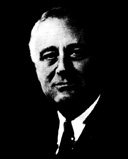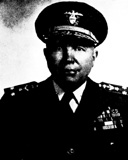



Ross T McIntire, Vice Admiral (MC) USN (Retired), Surgeon General, United States Navy, 1938 to 1946.
The achievements of military medicine in World War II were numerous and remarkable, and the results equally remarkable. Out of every 100 wounded men 98 recovered, in contrast with the experience in World War I, when only about 90 recovered out of every 100 wounded men. In earlier wars, one-half or more of all wounded men died as a result of their injuries. The World War II recovery rate for some injuries was striking; as an example, deaths from wounds of the head, chest, and abdomen were about 65 percent lower than in World War I. Foreword
The chief reason why so many more lives were saved in World War II was the high standard of professional skill and training of the physician, dentist, nurse, and corpsman. Further, skilled medical personnel were assigned to ships, planes, and amphibious forces in all parts of the world, and vast quantities of medical supplies-drugs, serums, plasma, whole blood, beds, bedding, and hospital equipment and appliances‹were provided for every operating force no matter where located.
Although the war officially began for the United States on 7 December 1941, the conflagration in Europe in the fall of 1939 was a portent and preparations were then made to meet the approaching national danger. These included a vast expansion of the Navy and its Medical Department. At the beginning of the war the Medical Department of the Navy consisted of less than 13,000 persons; in 1945, at the peak of expansion, it included 169,225 men and women. To obtain the medical facilities and supplies necessary for this expansion was a task of great magnitude.
Many new hospitals were built, and suitable buildings and grounds were acquired and converted to special hospitals. Overseas, the mobile hospital was an innovation that proved of immense value. Hospital transports were of great importance in the campaigns in the Central and Western Pacific. Hospital ships were an invaluable asset, not only in furnishing hospitalization for personnel in fleet and amphibious forces, but also in acting as floating medical warehouses for the distribution of medical supplies, serums, plasma, and whole blood. The use of some types of landing craft as hospitals and for the collection of casualties during amphibious landings was also a most important development.
The procurement of drugs, vaccines, serums, surgical dressings and instruments, and hospital equipment and appliances of every type was a vast undertaking which was well done, but the prompt and efficient distribution of these supplies to the Navy in every part of the world was the really great achievement.
The prevention of disease was as important as the care of the sick and
wounded; personnel were vaccinated against such diseases as smallpox, typhoid fever, typhus fever, tetanus, yellow fever, and cholera. This resulted in the saving of countless lives and prevented the disastrous effects of epidemic disease in the combat forces. The measures instituted for the prevention of malaria, typhus fever, and other diseases were guides to the success of many campaigns.Dental officers and dental personnel played an important part in the war. They gave first aid to the wounded and rendered the finest dental care. Mobile dental units were built to care for personnel attached to isolated stations where regular dental service could not be maintained. A program of prosthetic dentistry was developed which saved valuable manpower for the Navy. Working with the plastic surgeon, the dental officers devised prosthetic facilities for oral, facial, and eye wounds that facilitated the repair of these serious and disfiguring injuries and hastened the rehabilitation of the injured or blinded man.
This war emphasized the great importance of the specialities of aviation medicine, submarine medicine, and amphibious medicine. The latter was so completely organized that medical assistance was brought to the wounded men on the beachhead or in the field at the very earliest moment; never before had it been possible to bring first aid to men on the field of battle so early.
The Hospital Corps of the Navy played a great and heroic part in this as in every other war since its establishment in 1898. Everywhere they were conspicuous for their courage and devotion to duty. The lives of many men were saved by their fearlessness and by the skillful care they rendered.
The splendid work done by the Navy Nurse Corps in World War I was repeated in World War II. In hospitals at advance bases and in hospital ships and hospitals all over the world they carried out their mission tirelessly and efficiently. Their effect on morale, and the comfort and assistance they rendered to the sick was invaluable. The Women Appointed for Volunteer Emergency Service, newly organized in World War II, rendered the finest assistance to the Medical Department in the special fields allied to medicine.
Developments in medicine and surgery and their application to military medical problems made necessary a program of continuous research. The newly established Naval Medical Research Institute at Bethesda, Md., formed the center of this work in the field of naval military medicine. Here, as well as at other naval medical activities, workers in the sciences allied to medicine, the physiologist, psychologist, physicist, chemist, bacteriologist, botanist, and entomologist (added to the family of the Medical Department during World War II), carried on research problems, and their work contributed to the prevention of disease, the relief of suffering, and the saving of lives.
As the wartime Surgeon General of the Navy, I am proud to have directed the Medical Department in its great tasks. I also had the honor to serve as White House physician. This made my work greater, for frequently I was away from Washington on the various long journeys made by President Roosevelt to
attend conferences or inspect military forces in the field. These travels, however, gave me a great advantage, for they enabled me to visit almost all theaters of war and to observe the needs and problems of the medical activities in the field.The great responsibilities imposed upon the Medical Department of the Navy by the war were discharged so efficiently because of the skill, the courage, and the unswerving devotion to duty of all members of the Medical Department, from the hospital apprentice to the personnel of the office of the Surgeon General. Their magnificent achievements in medicine during World War II were unprecedented and were symbolized by President Roosevelt at the dedication ceremonies of the National Naval Medical Center where he said: "Let the hospital stand for all men to see through all the years as a monument to our determination to work and to fight until the time comes when the human race shall have that true health in body and spirit which can be realized only in a climate of equity and faith."
ROSS T McINTIRE
Vice Admiral (MC) USN (Retired)1
Early in World War II, President Roosevelt directed the "preserving for those who come after us an accurate and objective account of our present experience," and on 23 March 1942 a "Committee on Records of World War II" was designated to activate such a program. In the Navy, Surgeon General McIntire ordered the medical departments of all ships and stations to include in their Annual Sanitary Report an account of their experiences in administrative matters as well as in clinical and preventive medicine. These reports covered the period from 7 December 1941 to 31 August 1945. Preface
In 1943 an Administrative History Section was designated in the Administrative Division of the Bureau. This group assembled a Historical Data Series from the Annual Sanitary Reports and, under the general rules prescribed by the Director of Naval History, compiled the "U.S. Navy Medical Department Administrative History 19411945."
The data for chapters I and II were obtained from the sources mentioned. The remaining chapters were written, individually or in collaboration, by 37 naval officers, each recording the accomplishments of the Medical Department of the Navy in the field with which, by virtue of wartime experience, he was peculiarly familiar. The Aviation Branch of the Research Division of the Bureau compiled the section of Chapter X on Naval Aviation Medical Research.
The original work of assembling and editing this material was accomplished by Capt. Louis H. Roddis (MC) USN (Retired), who acted as editor until 30 June 1950. At that time Capt. Joseph L. Schwartz (MC) USN took over the task and completed a major part of it before his retirement on 7 August 1951.
This history is not an exhaustive report, but merely highlights the successful manner in which the 169,225 officers and men of the Medical Department coped with unprecedented problems in clinical and preventive medicine and in medical administration during the war. New hospital facilities were required to fit a new type of warfare, and the transportable, self-contained hospital was devised. New types of vehicles for medical care and transportation of patients were needed, and the jeep ambulance, the amphibious surgical unit, the hospital-type LST, and the ambulance plane were developed. Penicillin, whole blood, and plasma were made available in every battle zone. When necessary, blood was flown directly from the United States to the combat area. During the battle of Iwo Jima, whole blood was dropped by parachute to medical units in action in the field 48 hours after the plane had taken off from San Francisco. For the first time in military history, teams of epidemiologists accompanied
assault forces, and field sanitation, hygiene, and preventive medicine were immediately instituted. These teams were a vital factor in lowering the morbidity and mortality rates in combat troops.Officers of the Medical, Dental, Nurse, and Hospital Corps, specialists in fields allied to medicine, WAVES, and Hospital Corpsmen brought to the patient the best in clinical medicine. By their ability, resourcefulness, and devotion, they achieved results never before attained in military medicine. Volume I of The History of the Medical Department of the U. S. Navy in World War II is a partial record of their accomplishments and a testimony to their capable performance.
BENNETT F. AVERY
Captain (MC) USN, Editor
Table of Contents ** Next Chapter (1)
[1] Surgeon General, U.S. Navy, 1938-46, and Physician to the White House, 1938-45. Footnotes